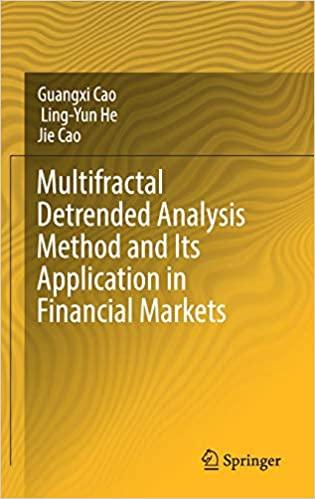Question
8b. What three steps are necessary for a U.S. investor to invest in Japanese bonds? (page 679) 8c. What is the interest rate on a
| 8b. What three steps are necessary for a U.S. investor to invest in Japanese bonds? (page 679) | |||||||
| 8c. What is the interest rate on a similar U.S. bond given the information below. (pages 678-679) | |||||||
| 90-day return on Japanese bonds | 1.00% | ||||||
| Spot exchange rate for Japanese Yen | $0.009144 | ||||||
| 90-day forward exchange rate for Japanese Yen | $0.009184 | (dollar expected to depreciate) | |||||
| 90-day return on U.S. bonds | (Solution: 1.442% vs. 1.436% in textbook) | ||||||
The relationship between spot and forward exchange rates and interest rates, which is known as interest rate parity, is expressed in the following equation: Forward exchange rate Spot exchange rate 5 (1 1 rh) (1 1 rf ) Both the forward and spot rates are expressed in terms of the amount of home currency received per unit of foreign currency, and rh and rf are the periodic interest rates in the home country and the foreign country, respectively. If this relationship does not hold, currency traders will buy and sell currenciesthat is, engage in arbitrageuntil it does hold. To illustrate interest rate parity, consider the case of a U.S. investor who can buy default-free 90-day Japanese bonds that promise a 4% nominal return. The 90-day interest rate, rf , is 4%/4 5 1% because 90 days is one-fourth of a 360-day year. Assume also that the spot exchange rate is $0.009144, which means that you can exchange 0.009144 dollar for 1 yen, or 109.36 yen per dollar. Finally, assume that the 90-day forward exchange rate is $0.009184, which means that you can exchange 1 yen for 0.009184 dollar, or receive 108.89 yen per dollar exchanged, 90 days from now.
The U.S. investor can receive a 4% annualized return denominated in yen, but if he or she ultimately wants to consume goods in the United States, those yen must be converted to dollars. The dollar return on the investment depends, therefore, on what happens to exchange rates over the next 3 months. However, the investor can lock in the dollar return by selling the foreign currency in the forward market. For example, the investor can do the following simultaneously: Convert $1,000 to 109,360 yen in the spot market. Invest the 109,360 yen in 90-day Japanese bonds that have a 4% annualized return or a 1% quarterly return and hence will pay (109,360)(1.01) 5 110,453.60 yen in 90 days. Agree today to exchange the 110,453.60 yen 90 days from now at the 90-day forward exchange rate of 108.89 yen per dollar, for a total of $1,014.36. This investment, therefore, has an expected 90-day return of $14.36/$1,000 5 1.436%, which translates into a nominal return of 4(1.436%) 5 5.74%. In this case, 4% of the expected 5.74% return is coming from the bond itself, and 1.74% arises because the market believes the yen will strengthen relative to the dollar. Note that by locking in the forward rate today, the investor has eliminated any exchange rate risk. And because the Japanese bond is assumed to be default-free, the investor is assured of earning a 5.74% dollar return. Interest rate parity implies that an investment in the United States with the same risk as this Japanese bond should have an annual return of 5.74%. Solving for rh in the parity equation, we indeed find that the predicted annual interest rate in the United States is 5.74%. Interest rate parity shows why a particular currency might be at a forward premium or discount. Note that a currency is at a forward premium whenever domestic interest rates are higher than foreign interest rates. Discounts will prevail if domestic interest rates are lower than foreign interest rates. If these conditions do not hold, arbitrage will soon force interest rates back to parity. Indeed, a recent study found that under normal economic conditions, interest rate parity holds remarkably well. However, significant deviations from parity did exist during the 20072009 financial crisis, when the lack of liquidity made it more difficult to arbitrage.
Step by Step Solution
There are 3 Steps involved in it
Step: 1

Get Instant Access to Expert-Tailored Solutions
See step-by-step solutions with expert insights and AI powered tools for academic success
Step: 2

Step: 3

Ace Your Homework with AI
Get the answers you need in no time with our AI-driven, step-by-step assistance
Get Started


